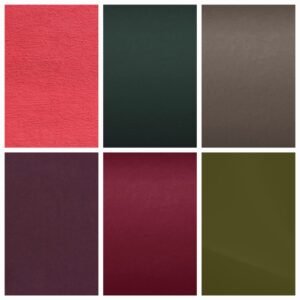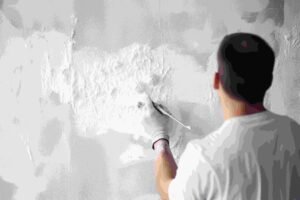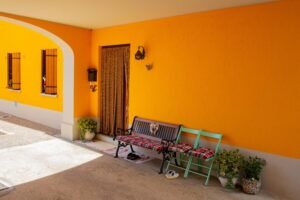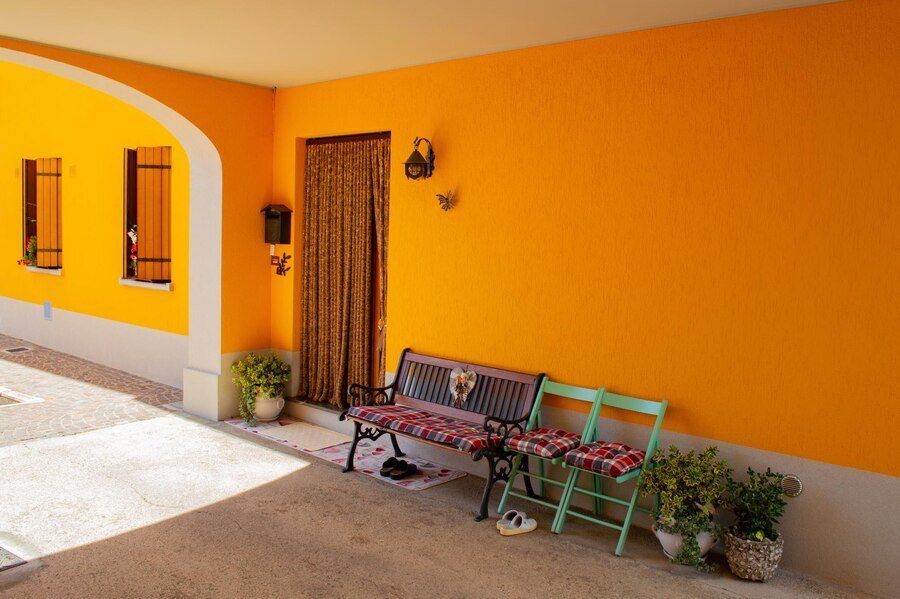Introduction to Exterior Wall Paints
Exterior wall paints are essential for the protection and beautification of homes. Unlike interior paints, which are formulated primarily for aesthetic purposes within a controlled environment, exterior paints are specifically designed to withstand the rigors of outdoor conditions. They are exposed to varying weather elements, including sunlight, rain, wind, and temperature fluctuations, requiring them to possess unique properties that ensure durability and long-lasting performance.
The formulation of exterior paints typically involves a different set of ingredients compared to their interior counterparts. These paints contain higher levels of UV resistance to prevent fading, along with enhanced adhesive properties to resist peeling and cracking. Furthermore, some exterior paints are designed to repel water, helping to protect the underlying materials of the home, such as wood and masonry, from moisture damage. This protective capability is vital to maintaining the structural integrity of a house, as exposure to water can lead to significant long-term issues, including mold and rot.
In addition to their protective qualities, exterior wall paints play a crucial role in enhancing the aesthetic appeal of a home. A well-chosen color and finish can significantly elevate a property’s curb appeal, making it more inviting and visually striking. Homeowners today often seek options like the mithila home paint, renowned for their vibrant colors and superior finish. Furthermore, the range of available textures and sheens allows individuals to customize the look of their homes according to their personal style preferences.
As we delve deeper into the various types, applications, and factors to consider when selecting exterior wall paints, it is essential to understand these fundamental differences. This foundation will aid homeowners in making informed decisions that cater not only to aesthetics but also prioritize the longevity and sustainability of their exterior spaces.

Understanding Paint Types: Key Differences
Choosing the right paint for exterior walls requires a comprehensive understanding of different paint types available in the market. Among the most common categories are latex paints, oil-based paints, acrylic paints, and elastomeric paints, each serving distinct purposes and exhibiting unique characteristics.
Latex paint, primarily water-based, is known for its ease of application and quick drying time. It typically offers good breathability, which helps prevent moisture from becoming trapped, a crucial aspect for exterior walls. Additionally, latex paints are available in a wide array of colors and finishes, allowing homeowners to achieve their desired aesthetic. However, they can sometimes struggle with durability in extreme weather conditions compared to other types.
Oil-based paints are renowned for their robust durability and high-gloss finish. They are particularly effective on surfaces that require a tough, long-lasting coating. Their resistance to wear and water makes them a preferred choice for surfaces exposed to the elements. However, oil-based paints have longer drying times, emit stronger odors, and necessitate the use of solvents for cleanup.
Acrylic paints are often considered an upgraded version of latex paints. They provide excellent adhesion and color retention while being highly resistant to fading, making them suitable for diverse climates. Acrylic paints are particularly beneficial for application on masonry and stucco, frequently embraced by those looking to apply mithila home paint for a long-lasting finish. Conversely, they may be costlier than traditional latex paints.
Lastly, elastomeric paints form a thick, flexible coating that can stretch and contract with surface movement, ideal for surfaces prone to cracking. This type of paint is often utilized in extreme weather areas, offering superior waterproofing. However, due to its thickness, application may require specific techniques and skills.
By understanding the characteristics, advantages, and disadvantages of each paint type, homeowners can make informed decisions that align with their specific needs and the unique demands of their homes.

Choosing the Right Finish: Matte, Satin, Gloss
When selecting an exterior wall paint for your home, the finish plays a crucial role in both durability and aesthetic appeal. The three primary finishes—matte, satin, and gloss—offer distinct characteristics and benefits that can greatly influence the appearance and maintenance of your home’s exterior. Understanding these options can help homeowners make informed decisions about their choice of mithila home paint.
Matte finishes are known for their non-reflective surface, providing a smooth and rich appearance. They are often favored for their ability to hide imperfections on walls and offer a sophisticated look. However, while matte paint can add a touch of elegance, it may not stand up to the wear and tear of outdoor conditions as effectively as its shinier counterparts. This makes it less suitable for areas that face heavy moisture or exposure to the elements.
Satin finishes, on the other hand, strike a balance between matte and gloss. They offer a subtle sheen that reflects some light, enhancing the color vibrancy while still concealing minor imperfections. Satin paints are more durable and easier to clean than matte finishes, making them an excellent choice for exterior walls that require regular maintenance. Additionally, the satin finish tends to be more resistant to fading, which is a significant consideration for homeowners in sunny climates.
Gloss finishes provide the highest level of sheen and are ideal for creating a striking and polished look. While they offer exceptional durability and are easy to clean—able to withstand harsh weather and frequent washing—they can also highlight imperfections in the surface of the wall. As such, gloss finishes are often used for architectural details, trim, or in regions of a home that require heightened durability.
Ultimately, selecting the correct finish for your mithila home paint involves considering both aesthetic preferences and practical needs. Each finish has its advantages and can dramatically change how your home looks and endures the elements.

Color Selection: Trends and Tips
Choosing the right color for your exterior wall paints can significantly enhance the overall appearance of your home. The architecture of your house plays a crucial role in determining suitable paint shades. Traditional homes often benefit from classic hues such as soft whites, muted pastels, and rich earth tones. Conversely, modern architecture may allow for bolder, more vibrant colors, which can create a striking contrast against clean lines and geometric shapes.
In addition to architectural style, observing neighborhood trends can provide valuable insights into effective color selection. Homes within a community often share color themes or palettes, contributing to an overall harmonious atmosphere. While it is tempting to maintain conformity, incorporating your personal preferences allows for individuality without compromising overall aesthetic appeal. The objective is to choose a shade that aligns with both community standards and your taste, ensuring that your abode stands out while also complementing its surroundings.
Current trends have seen a rise in earthy and neutral tones, such as sandy beiges, grays, and deep greens, reflecting a connection to nature. These colors can create a calming atmosphere and blend seamlessly into the landscape. Additionally, seasonal trends often influence color decisions; warm hues may be more popular in the summer months, while cooler tones can evoke a sense of coziness during winter. Non-traditional color choices, such as dark blue or charcoal, can add a contemporary flair, especially when paired with contrasting trim.
Ultimately, selecting the perfect color for your exterior wall paints, like mithila home paint, involves a blend of practical considerations and personal expression. By reflecting on architectural elements, neighborhood aesthetics, and trending colors, homeowners can confidently choose shades that enhance their home’s exterior while remaining true to their style.

Surface Preparation: Essential Steps Before Painting
Proper surface preparation is an essential step in the painting process that can significantly influence the final appearance and longevity of the paint applied to your home. When embarking on a project involving exterior wall paints, it is imperative to take the time to prepare the surfaces adequately. This begins with thorough cleaning, which removes dirt, grime, and any loose materials that could interfere with paint adhesion. Utilizing a pressure washer or a simple scrub with a suitable detergent can make a notable difference in ensuring a clean surface for the paint application.
Following the cleaning process, it is critical to inspect the walls for any damage. Look for signs of peeling, cracking, or mildew, as these defects can compromise the paint’s effectiveness. Any damaged areas should be repaired promptly, whether that involves patching cracks with a filler, replacing damaged boards, or treating areas affected by mold. This not only enhances the aesthetic appeal but also ensures that the paint will adhere properly to a structurally sound surface.
Sanding is another vital step in the preparation process. Sanding helps to smooth out rough areas and removes any traces of old paint that might affect the new coat’s finish. Using the appropriate grit sandpaper can refine the surface, which is crucial for achieving a professional-looking result with your chosen mithila home paint. Additionally, once sanding is complete, cleaning the area again is necessary to eliminate any dust that may have accumulated.
Finally, priming the exterior walls provides an additional layer of protection and enhances the adhesion of the final coat of paint. Choosing the right primer, particularly one compatible with your Mithila home paint choice, can greatly affect the durability and vibrancy of the finish. With these essential steps of cleaning, repairing, sanding, and priming, you lay a strong foundation for a successful painting project, ensuring that your home reflects its best appearance for years to come.

Application Techniques: Tools and Methods
Choosing the appropriate application techniques for mithila home paint is crucial for achieving an aesthetically pleasing finish on your exterior walls. Multiple tools and methods are available, each suited for different types of paint and surfaces. Understanding these can enhance the application process, ensuring an even, smooth, and durable finish.
Brushes, for instance, are one of the most traditional tools for applying exterior paints. They are particularly useful for precise areas, such as corners and edges, where larger tools may not reach effectively. A high-quality natural or synthetic bristle brush can offer excellent results and paint adherence. When using a brush, applying the paint in long, even strokes will promote uniform coverage.
Rollers are another popular application method, particularly for large, flat surfaces. A roller can cover more area quickly compared to a brush, making it ideal for sprawling exteriors. It is essential to select a roller with the appropriate nap length based on the texture of the surface; for instance, a short nap is suitable for smooth surfaces, while a longer nap is effective for textured walls. Using a paint tray can streamline the roller application, reducing splatter and allowing for smoother coverage.
For those seeking efficiency, spray guns provide a modern alternative. They allow for quick application over large areas, making them ideal for bigger projects. However, proper technique and equipment handling are vital, as overspray can result in paint waste and uneven coverage. Protective gear is also necessary to ensure safety while using these tools. Each of these methods can deliver excellent results if executed properly, emphasizing the importance of selecting the right tools based on the specific exterior surface and environment.
Weather Considerations: Timing Your Painting Project
When planning an exterior painting project, one of the most critical factors to consider is the weather. The right climatic conditions can significantly impact the performance and longevity of your chosen paint, which is particularly true for a product like mithila home paint. Ideally, the best time for such projects is during the spring or fall, when temperatures are moderate and humidity levels are generally lower.
Temperature plays a vital role in the application of exterior paint. Most paints, including those formulated for durability, perform optimally when applied in temperatures ranging from 50°F to 85°F (10°C to 29°C). If you paint in conditions that are too cold, the paint may not adhere properly, leading to peeling or chipping over time. Conversely, high temperatures can cause the paint to dry too quickly, resulting in an uneven application. This is particularly important to consider when working with mithila home paint, which is designed for optimal performance under specific conditions.
Another essential factor is humidity. High humidity can prolong drying times and increase the likelihood of mold and mildew forming beneath the paint layer. It is advisable to avoid painting on days when humidity levels exceed 70%. Instead, aim for days with a relative humidity between 40% and 60% to ensure a successful and lasting finish. Monitoring weather forecasts can provide valuable information, helping you select a time when both temperature and humidity are favorable for painting.
In conclusion, timing your exterior painting project with consideration of weather conditions is crucial. By aiming for the appropriate seasons and keeping an eye on temperature and humidity levels, you can effectively enhance the durability of finishes such as mithila home paint, ensuring that your home looks beautiful and remains protected against the elements for years.
Maintenance Tips for Longevity
Once the exterior walls of your home are painted with quality products like mithila home paint, regular maintenance is crucial to ensure the longevity of the finish. A well-maintained paint job not only enhances the aesthetic appeal of your home but also protects the substrate beneath. To start, implementing a regular cleaning schedule is essential. Ideally, the exterior surfaces should be cleaned every six to twelve months, depending on environmental conditions. Use a mild detergent mixed with water and a soft brush to gently scrub the walls, being careful not to damage the paint. This helps in removing dirt, mildew, and other contaminants that can lead to premature deterioration.
Identifying common damage is another key aspect of maintaining your painted surfaces. Look for signs of peeling, chipping, or fading paint. These issues often result from weather exposure or improper application during the initial paint job. If you notice such problems, it’s important to address them as soon as possible to prevent further damage. Small touch-ups can often be made with leftover mithila home paint, ensuring a seamless repair without needing to repaint the entire wall.
Additionally, knowing when to repaint is crucial for maintaining the beauty and integrity of your home’s exterior. Typically, high-quality exterior paints can last from five to ten years, but this can vary based on factors such as climate, sun exposure, and the material underneath the paint. If you observe that the paint is no longer adhering well, has significant fading, or shows signs of structural damage, it may be time to consider a full repaint. By following these maintenance tips, homeowners can enjoy their beautifully painted exteriors for many years, maximizing the investment made in products like mithila home paint.
Conclusion: Making Your Home Shine with the Right Exterior Paint
Choosing the appropriate exterior wall paint is a vital decision for any homeowner aiming to enhance their property’s curb appeal. The selection process is multifaceted; it involves understanding various paint types, finishes, and colors to ensure compatibility with your home’s architecture and environment. Each paint variant, whether it’s the durable satin, the sophisticated matte, or the vibrant gloss, has unique qualities that can significantly impact the aesthetics over time.
As discussed, preparation plays an equally significant role in the successful application of mithila home paint or any other variant. Proper surface cleaning, priming, and choosing the right tools can greatly affect the longevity and appearance of the final finish. Ignoring these preparatory processes can lead to premature chipping and fading, undermining the efforts invested in choosing the perfect color for your walls.
Furthermore, considering weather conditions and local climate trends will guide homeowners in selecting paints specially formulated for prolonged durability. Manufacturers often provide products designed to withstand specific environmental challenges, ensuring that your home not only looks beautiful but also is protected against the elements. By investing in high-quality mithila home paint or any well-suited exterior paint, homeowners will secure a long-lasting finish that accentuates their property while also adding value.
Ultimately, the combination of thoughtful color choice, understanding paint properties, and diligent preparation will lead to a stunning exterior that complements both the house and its surroundings. Taking the time to make informed decisions regarding exterior wall paints will pay off tremendously, transforming the overall appeal of your home and creating welcoming impressions for visitors and passersby alike.


